- There are no more items in your cart
- Shipping Calculated at checkout
- Sub-Total (inc. VAT) £0.00
Need Help?
Damp Proof Paints
Plagued with damp problems? Damp-proof paints are specially formulated coatings designed to prevent moisture from penetrating interior and exterior surfaces. These paints form an impermeable barrier that stops dampness from seeping through walls, ceilings, and floors, thus protecting buildings from the damaging effects of damp. The primary function of these paints is to create a protective layer that resists water ingress, safeguarding both the structural integrity and aesthetic appearance of buildings. Damp-proof paints are essential in areas prone to high humidity, water ingress, and damp issues, such as basements, bathrooms, kitchens, and exterior walls. They not only prevent the immediate problems associated with damp but also mitigate long-term damage and health risks. Click here for more info.
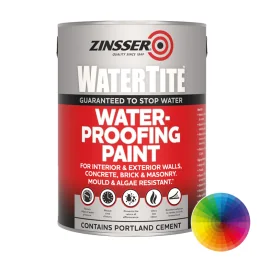
Zinsser Watertite
40+ off-white and pastel tones. For interior and exterior concrete, stucco, cement, cinder block, and masonry surfaces. Keeps water out and prevents mould and mildew for up to 5 years. Twice the strength of latex waterproofers with a smooth finish. Low-odour, solvent-based formula suitable for wet or dry surfaces. Fast drying, recoat in...

Coo-Var Anti-Damp Paint
White efflorescence-resistant resin-based paint. For interior damp walls and ceilings. Suitable for damp plaster, cement, and stone. Contains a biocide to preserve the dry film and reduce discolouration.

SmartSeal Damp Proof Paint
5 colours in a matt finish. Effective waterproofing paint for walls and floors. Quick drying. Solvent free.
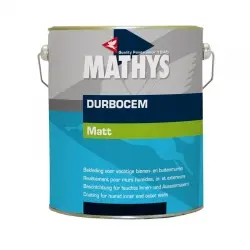
Rust-Oleum Mathys Durbocem
Available in white. Suitable for humid inner and outer walls, and cellars. Adheres well to damp and chalking substrates. Can be recoated when the substrate is dry. Formulated with plasticized acrylic resins for enhanced durability.
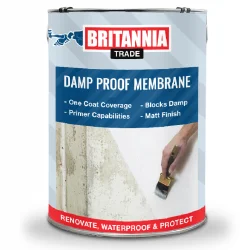
Britannia Damp Proof Paint
A damp proof paint that incorporates a water reactive agent to take care of residual surface moisture on interior walls.Ready for use Solvent based pliolite resin matt coating Can also be used as a damp proofing primer/sealer prior to over-painting Use on damp interior wall surfaces including brick, concrete, cement and plaster (not...
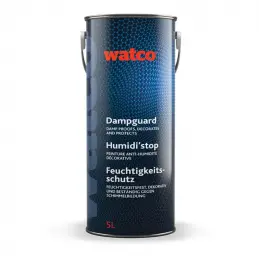
Watco Fast Drying Dampguard
Damp-proofs, decorates and resists mould growth, creating an easy to clean surface on damp walls, above or below ground level, and in basements.Resists up to 2 bars of water pressure Fast drying - recoatable in 4 hours Prevents water seepage through cement, masonry, concrete block walls and basement floor slabsMore Info Delivery...
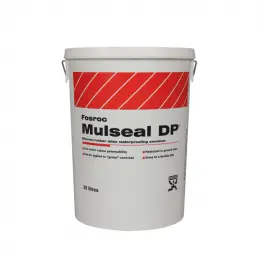
Fosroc Mulseal DP
Bitumen rubber / latex compound designed for use in damp proofing applications. Mulseal DP is suitable for uses such as a damp proof membrane to retaining walls, as a vapour barrier to panels and repairing fine cracks in asphalt surfaces.Suitable for use on most building materials such as concrete, brickwork, metals and stone. Complies...
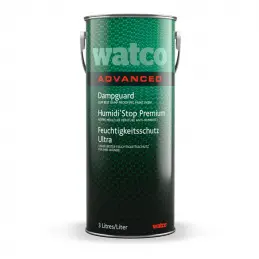
Watco Dampguard Advanced
A hardwearing epoxy resin damp-proofing and anti-fungal coating for walls and floors, cellars, basements and tunnels, laundries, food storage areas, kitchens and dairies. Scrubbable chemical resistant formula Resists 2 bars (35psi) of pressure Low odour - use in confined areas Fast-Drying Dampguard also availableNote: While great...
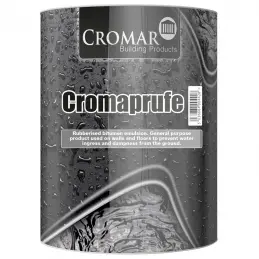
Cromar Cromaprufe
Rubberised bitumen emulsion, general-purpose product used on walls and floors to prevent water ingress and dampness from the ground. Can also be used as wood block floor adhesive.Provides a waterproof membrane on concrete and brick foundations, retaining walls and bridge abutments. Protects concrete structures against attack by sulphates...
Need Help?
Need Help?
Understanding Damp Problems
Damp problems can arise from various sources and cause significant damage to buildings if not adequately addressed. Damp can manifest in three primary forms: rising damp, penetrating damp, and condensation. Each type of damp has different causes and requires specific treatments.
Rising Damp: Rising damp occurs when groundwater rises through the walls and floors of a building by capillary action. This is often due to a failed or nonexistent damp-proof course, which is a physical barrier designed to prevent such upward moisture movement. Rising damp typically affects older buildings but can also occur in newer structures if the damp-proof course is compromised.
Penetrating Damp: Penetrating damp results from water entering a building through its exterior walls, roofs, or windows. This type of damp is usually caused by defects in the building’s exterior, such as cracked walls, faulty roofing, or poor window seals. It can also be exacerbated by external factors like driving rain or poorly maintained drainage systems.
Condensation: Condensation happens when moist air comes into contact with cold surfaces, leading to water droplets forming on walls, ceilings, and windows. This is particularly common in poorly ventilated areas where humidity levels are high, such as bathrooms, kitchens, and laundry rooms.
Understanding the type of damp affecting a property is crucial for selecting the appropriate treatment and preventative measures. Addressing the root cause of the damp is essential for effective long-term management and prevention.
Causes of Damp
Damp can be caused by various factors, each requiring different preventative and remedial actions:
Structural Defects: Defects in the building’s exterior, such as cracks in walls, damaged roofing, or poor window seals, can allow water to penetrate and cause damp. Regular inspection and maintenance of the building's envelope can help prevent these issues.
Poor Maintenance: Neglecting regular maintenance tasks, such as clearing gutters and repairing leaks, can lead to water ingress and damp problems. Ensuring that the building is well-maintained and all potential entry points for water are addressed can significantly reduce the risk of damp.
High Humidity: Environments with high humidity levels, particularly in bathrooms and kitchens, can experience condensation and damp issues. Proper ventilation and humidity control measures are essential in these areas to prevent damp problems.
Water Leaks: Leaks from plumbing systems, roofs, or windows can introduce excess moisture into the building, leading to damp. Promptly addressing and repairing leaks can prevent water from seeping into the structure and causing damage.
Areas Most Prone to Damp
Damp can affect various parts of a building, depending on the source of moisture. Identifying these high-risk areas allows for targeted application of damp-proof paints and other preventative measures to protect the building.
Basements and Cellars: These below-ground areas are especially vulnerable to rising damp and penetrating damp due to their contact with the soil. Moisture from the ground can easily seep into basements and cellars if they are not adequately protected. Applying damp-proof paint to these areas can help create a barrier that prevents moisture ingress.
Bathrooms and Kitchens: High humidity levels from showers, baths, and cooking can lead to condensation and damp. These rooms are prone to moisture build-up, making them ideal candidates for damp-proof treatments. Using damp-proof paint in bathrooms and kitchens can help protect surfaces from water damage and mould growth.
Exterior Walls: Walls exposed to heavy rainfall and wind-driven rain are prone to penetrating damp. Ensuring that exterior walls are properly sealed and protected with damp-proof paint can prevent water from entering the building and causing damp issues.
Floors: Ground floors without adequate damp-proof membranes can suffer from rising damp. Applying damp-proof paint to floors can provide an additional layer of protection against moisture penetration.
Damp-Proof Paint: How It Works
Damp-proof paints are formulated with advanced water-resistant agents, resins, and often include biocides to prevent mould growth. These paints work by forming a continuous, impermeable barrier that stops moisture from penetrating the surface. When applied, damp-proof paints penetrate the surface and bond with the substrate, creating a protective layer that resists water ingress.
Typically, a two-coat system is recommended for optimal protection:
- First Coat: The first coat acts as a primer and sealer, preparing the surface and ensuring that the final coat adheres properly. This initial layer helps to fill any minor cracks or imperfections in the surface, providing a smooth base for the final coat.
- Second Coat: The second coat provides a durable, moisture-resistant finish. This layer reinforces the barrier created by the first coat, offering long-lasting protection against damp.
The application of damp-proof paint not only prevents moisture from penetrating the surface but also helps to maintain the appearance and integrity of the treated area. These paints are especially beneficial in areas with persistent damp problems, offering a practical and effective solution for moisture management.
Other Methods to Prevent Damp
In addition to using damp-proof paints, several complementary measures can help manage and reduce damp problems effectively:
Improving Drainage: Ensuring proper drainage around the building to direct water away from the foundation is crucial. This can involve installing or maintaining gutter systems, downspouts, and drainage channels to prevent water from pooling near the building.
Repairing Defects: Fixing any defects in roofs, gutters, and downpipes to prevent water ingress is essential. Regular inspection and maintenance of these components can help identify and address issues before they lead to significant damp problems.
Installing Damp-Proof Courses: Installing or repairing damp-proof courses and membranes to prevent rising damp is a key preventative measure. These barriers are designed to block the upward movement of moisture from the ground into the building structure.
Improving Ventilation: Enhancing ventilation in high-humidity areas to reduce condensation is important. Installing extractor fans, opening windows, and using dehumidifiers can help maintain appropriate humidity levels and prevent moisture build-up.
By combining these methods with the application of damp-proof paints, property owners can create a robust defence against damp. Implementing a comprehensive damp management strategy helps ensure that buildings remain dry, structurally sound, and healthy for occupants.
Seasonal and Structural Considerations
In the UK, damp issues are more prevalent during the autumn and winter months due to increased rainfall and lower temperatures. Seasonal changes can significantly impact the severity and frequency of damp problems. Understanding these seasonal patterns is essential for effective damp management.
- Autumn and Winter: During these colder months, increased rainfall and lower temperatures can exacerbate damp issues. Buildings with poor insulation, inadequate damp-proof courses, and faulty drainage systems are particularly vulnerable. The combination of rain and cold weather can lead to higher humidity levels indoors, increasing the risk of condensation and damp.
- Spring and Summer: Although damp problems are generally less severe during the warmer months, they can still occur, especially in poorly ventilated areas. Regular maintenance and inspection during these periods can help identify and address potential damp issues before they become problematic.
Structural elements such as uninsulated walls and poorly maintained roofs can exacerbate damp problems. Ensuring that buildings are well-maintained and adequately protected can help mitigate the seasonal impacts of damp. Property owners should focus on improving insulation, repairing structural defects, and maintaining proper ventilation to reduce the risk of damp throughout the year.
Health Risks Associated with Damp
Damp environments can lead to various health problems, including respiratory issues, allergies, and asthma. The presence of damp and mould in a building can significantly impact indoor air quality and pose serious health risks to occupants.
Respiratory Issues: Exposure to damp and mould can cause respiratory problems, including coughing, wheezing, and shortness of breath. Individuals with pre-existing respiratory conditions, such as asthma, are particularly vulnerable.
Allergies: Damp environments can trigger allergic reactions, including sneezing, runny nose, and itchy eyes. Mould spores and other allergens thrive in damp conditions, exacerbating these symptoms.
Asthma: The World Health Organization (WHO) has highlighted that damp and mouldy environments increase the risk of asthma and exacerbate existing asthma symptoms. Children, the elderly, and individuals with compromised immune systems are especially at risk.
The UK government provides guidelines for maintaining healthy indoor environments to mitigate the health risks associated with damp. These guidelines emphasise the importance of proper ventilation, humidity control, and regular inspections to ensure that buildings remain dry and healthy for occupants.
Building Materials and Damp Resistance
Certain building materials are more susceptible to damp problems than others. Understanding the properties of different materials can help in taking preventive measures:
Brick and Concrete: These materials can absorb moisture if not properly sealed, leading to damp issues. Applying damp-proof paint can enhance their resistance to moisture and extend their lifespan.
Wood: Wood can warp, rot, and decay when exposed to moisture, compromising the structural integrity of the building. Damp-proof treatments can protect wooden surfaces from moisture damage.
Plaster and Drywall: These materials can become soft and crumbly when damp, leading to extensive damage and costly repairs. Damp-proof paint can provide a protective barrier that prevents moisture ingress.
Stone: While generally more resistant, certain types of stone can still suffer from damp penetration if not properly treated. Applying damp-proof coatings can help maintain the durability and appearance of stone surfaces.
Using damp-proof paints on these materials can enhance their resistance to moisture and help maintain the structural integrity of buildings.
Damp-Proof Paints in Various Sectors
Public Sector Buildings and Facilities
Public sector buildings such as schools, hospitals, and government offices often face damp issues due to high occupancy levels and varied usage patterns. These buildings require strict maintenance and protective measures to ensure the safety and well-being of occupants.
Schools: In schools, damp can affect classrooms, gymnasiums, and locker rooms. The presence of damp in these areas can compromise the health and safety of students and staff. Applying damp-proof paint can help create a healthier environment conducive to learning.
Hospitals: Hospitals need to maintain strict hygiene standards, and damp can compromise patient safety by fostering harmful bacteria. Using damp-proof coatings in hospitals can help maintain a sterile environment and protect patients from health risks.
Government Offices: Government offices with large, older buildings can also be vulnerable to damp problems. Damp-proof treatments can help preserve these historic structures and ensure a safe working environment for employees.
Public Use Areas and Communal Buildings
Community centres, libraries, and leisure centres experience high foot traffic and usage, leading to significant moisture generation. These buildings require effective damp management strategies to maintain a safe and comfortable environment for visitors.
Community Centres: Damp in community centres can affect meeting rooms, kitchens, and recreational areas. Using damp-proof paint can help protect these spaces from moisture damage and maintain their usability.
Libraries: Libraries are particularly susceptible to damp, which can damage books and other materials. Damp-proof treatments can help preserve valuable resources and ensure a safe environment for patrons.
Leisure Centres: Showers and changing rooms in leisure centres are prone to damp, which can pose safety hazards and health risks. Applying damp-proof coatings can help create a safer environment for users.
Commercial Buildings and Establishments
Commercial establishments such as offices, retail stores, and restaurants often struggle with damp in areas like restrooms, kitchens, and storage rooms. Effective damp management is crucial for maintaining a professional and hygienic environment.
Offices: Damp in office buildings can affect employee health and productivity. Using damp-proof paint can help create a healthier work environment and protect the building’s infrastructure.
Retail Stores: Retail stores with large display windows can experience condensation and damp issues. Damp-proof treatments can help maintain the appearance of the store and protect merchandise from moisture damage.
Restaurants: Restaurants generate large amounts of steam from cooking, making them susceptible to damp and mould growth. Applying damp-proof coatings in kitchens and storage areas can help maintain hygiene standards and protect food safety.
Industrial Plants and Food Processing Plants
Industrial facilities, including food processing plants, manufacturing, and packaging plants, face significant damp challenges. These environments require stringent hygiene standards and effective moisture control measures.
Food Processing Plants: Damp in food processing plants can lead to contamination and spoilage. Using damp-proof paint can help maintain a clean and safe environment for food production.
Manufacturing Plants: Manufacturing and packaging plants need effective damp management to maintain product quality and worker safety. Damp-proof treatments can help protect equipment and infrastructure from moisture damage.
Packaging Plants: Packaging plants must ensure that their products remain dry and free from contamination. Applying damp-proof coatings can help maintain the integrity of packaging materials and protect the contents.
Agricultural Sector
In agricultural settings, damp can be a significant problem in greenhouses, storage facilities, and animal housing. Effective moisture control is essential for maintaining optimal conditions for plant growth and animal health.
Greenhouses: Greenhouses need to maintain specific humidity levels for optimal plant growth, and damp can disrupt this balance. Damp-proof treatments can help create a controlled environment and prevent moisture-related issues.
Storage Facilities: Storage facilities for grains and other produce must remain dry to prevent spoilage. Applying damp-proof paint can help protect valuable resources and maintain their quality.
Animal Housing: Animal housing, where warmth and humidity levels are high, is susceptible to damp, potentially affecting animal health. Using damp-proof coatings can help create a healthier environment for livestock.
Damp-Proof Paints for Windows, Window Sills, Ceilings, and Walls
Windows and Window Sills
Windows and window sills are common sites for damp problems due to condensation. Single-glazed windows are particularly prone to this issue. Damp-proof paints can be applied around windows and sills to prevent moisture ingress and damp formation.
Double-Glazing: Upgrading to double-glazed windows can significantly reduce condensation and damp. This modern solution provides better insulation and reduces the likelihood of moisture problems.
Regular Ventilation: Ensuring proper ventilation helps reduce indoor humidity levels. Opening windows, using extractor fans, and employing ventilation systems can help keep moisture levels in check.
Dehumidifiers: Using dehumidifiers in rooms with high moisture levels can help control condensation and damp. These devices extract excess moisture from the air, making it less likely for damp to form on surfaces.
Ceilings and Walls
Damp on ceilings and walls is common in areas with poor ventilation and high humidity, such as bathrooms and kitchens. It can lead to unsightly stains, paint peeling, and health hazards.
Improved Ventilation: Installing extractor fans in high-humidity areas helps remove moist air before it can condense and cause damp problems. Proper ventilation is crucial for maintaining a dry and healthy indoor environment.
Damp-Proof Paint: Applying damp-proof paint to ceilings and walls provides a protective barrier that prevents moisture penetration. This treatment can help maintain the integrity and appearance of interior surfaces.
Insulation: Adding insulation to walls and ceilings can help maintain a consistent surface temperature, reducing the likelihood of condensation and damp. Proper insulation also enhances energy efficiency and comfort.
What Damp Issues Look Like
Identifying damp problems early can help prevent more serious issues from developing. Here are some common signs of damp:
Damp Patches: Dark, damp patches on walls and ceilings can indicate moisture ingress. These patches often feel cold and wet to the touch and can vary in size and shape.
Peeling Paint and Wallpaper: Moisture can cause paint to blister, peel, and flake off, and can make wallpaper bubble and detach from the walls. This is a clear indication of underlying damp problems.
Musty Smell: A musty odour indicates the presence of damp, even if it is not immediately visible. This smell is often associated with mould and mildew growth.
Efflorescence: White, powdery deposits on walls indicate rising damp. Efflorescence occurs when moisture brings salts to the surface, leaving behind a powdery residue.
Mould and Mildew: The growth of mould and mildew is a serious consequence of damp. Black spots of mould typically appear on walls, ceilings, around windows, and on other surfaces that remain damp. Mould can spread rapidly if not addressed promptly.
Consequences of Ignoring Damp
Ignoring damp issues can lead to a range of problems, affecting both the structure of buildings and the health of their occupants:
Structural Damage: Persistent damp can weaken the structural integrity of buildings by deteriorating materials such as wood, plaster, and brick. This can result in costly repairs and potential safety hazards.
Health Issues: Damp environments can cause respiratory problems, allergies, asthma, and other health issues. Prolonged exposure to damp and mould can exacerbate these conditions, especially in vulnerable individuals.
Damage to Interiors: Decorative finishes like paint, wallpaper, and plaster can suffer significant damage from ongoing damp problems. This not only affects the aesthetic appeal of a property but also increases maintenance costs.
Increased Maintenance Costs: Regular cleaning and redecoration can become necessary if damp is not properly addressed. Over time, the costs associated with managing damp can accumulate significantly.
Property Value: Properties with noticeable damp issues can suffer a reduction in value. Potential buyers may be deterred by visible signs of damp and the associated health risks and repair costs.
Comprehensive Damp Management
Effective management of damp involves a multifaceted approach that includes the use of damp-proof paints and other preventive measures:
Damp-Proof Paint: Applying damp-proof paint is a proactive measure to prevent damp from forming on walls and ceilings. These paints create a protective barrier that keeps surfaces dry and damp-free.
Ventilation: Improving ventilation through the installation of extractor fans, opening windows, and using dehumidifiers helps reduce indoor humidity levels. Adequate ventilation is essential for maintaining a dry and healthy indoor environment.
Insulation: Proper insulation of walls, ceilings, and windows helps maintain a consistent temperature, reducing the risk of condensation and damp problems. Insulating materials also enhance energy efficiency and comfort.
Regular Maintenance: Regular inspection and maintenance of buildings, including checking for leaks, repairing damaged surfaces, and ensuring proper insulation, are crucial in preventing damp. Addressing small issues promptly can prevent more significant problems from developing.
Professional Assessment: For severe cases, consulting with a professional can help identify the root cause of damp issues and recommend tailored solutions. Professionals can conduct thorough inspections and provide expert advice on the best measures to take.
By understanding the signs of damp and addressing them promptly with effective measures, property owners can protect their buildings from structural damage, maintain a healthy indoor environment, and avoid costly repairs. Damp-proof paints, combined with proper ventilation and insulation, offer a comprehensive solution to managing damp issues.
When to Call a Specialist
While many damp issues can be managed with DIY methods and regular maintenance, there are situations where professional intervention is necessary:
Signs You Need a Specialist
- Extensive Damp Problems: If damp affects a large area (more than 10 square feet) or multiple rooms, it's time to call a professional. Extensive damp issues may indicate underlying structural problems that require expert assessment and remediation.
- Recurrent Damp Issues: If damp keeps returning despite your efforts to fix it, there may be an underlying issue that needs professional assessment. Recurrent damp problems can be indicative of deeper issues that require specialised solutions.
- Health Symptoms: If occupants are experiencing unexplained respiratory problems, allergies, or other health issues that seem related to damp exposure, it’s crucial to seek professional help. Damp environments can pose serious health risks, and addressing these issues promptly is essential for maintaining a healthy living space.
- Structural Damage: If damp has caused visible structural damage to walls, ceilings, or floors, a specialist is needed to assess and repair the damage. Structural damage can compromise the safety and integrity of the building, requiring expert intervention.
- Water Damage: Damp resulting from significant water damage (like flooding or major leaks) often requires professional remediation to ensure all affected areas are thoroughly dried and treated. Proper remediation is crucial for preventing long-term damage and mould growth.
Benefits of Professional Help
- Thorough Inspection: Professionals can conduct a comprehensive inspection to identify the extent of damp problems and the underlying causes. This ensures that all aspects of the issue are addressed, preventing recurrence.
- Effective Remediation: Specialists have the tools and expertise to remove damp safely and effectively, preventing future problems. Professional remediation ensures that damp is thoroughly treated and the risk of recurrence is minimised.
- Health Protection: Professionals can ensure that damp remediation is done safely, protecting the health of building occupants. Proper treatment can reduce exposure to harmful mould and mildew, improving indoor air quality.
- Long-Term Solutions: By addressing the root causes of damp, professionals can provide long-term solutions that prevent recurrence. This approach helps protect the building's structural integrity and ensures a healthy living environment for occupants.
FAQs About Damp-Proof Paint
What is damp-proof paint?
Damp-proof paint is a specialised coating that creates a barrier to prevent moisture from penetrating walls, ceilings, and floors. It is designed to address issues related to rising damp, penetrating damp, and condensation.
How does damp-proof paint work?
Damp-proof paint works by forming an impermeable layer on the surface it is applied to, preventing moisture from passing through. It typically contains water-reactive agents and resins that bond with the substrate and create a moisture-resistant barrier.
Where can I use damp-proof paint?
Damp-proof paint can be used on interior and exterior walls, ceilings, and floors. It is ideal for basements, cellars, bathrooms, kitchens, and any area prone to damp problems.
Can damp-proof paint be overcoated?
Yes, some damp-proof paint can be overcoated with regular paint or wallpaper. However, always follow product data sheet instructions, as it may be recommended to use another layer of damp-proof paint for maximum protection. Ensure the underlying damp-proof paint is fully cured before applying any topcoat.
Is damp-proof paint effective on all surfaces?
Damp-proof paint is effective on most masonry surfaces, including brick, concrete, plaster, and stone. Proper surface preparation, such as cleaning and priming, is essential for optimal adhesion and effectiveness.
Does damp-proof paint prevent condensation?
While damp-proof paint helps prevent moisture penetration, it does not address the root cause of condensation. Proper ventilation and insulation are necessary to manage condensation effectively.
How long does damp-proof paint last?
The longevity of damp-proof paint depends on the environmental conditions and the quality of the application. Generally, it provides protection for several years before needing reapplication. Regular maintenance and inspection can extend its effectiveness.
Can I use damp-proof paint in commercial kitchens?
Yes, damp-proof paint is suitable for use in commercial kitchens and other high-humidity commercial environments. Its ability to withstand steam and moisture makes it ideal for these settings.
Is it safe to use damp-proof paint indoors?
Yes, it is safe for indoor use when applied according to the manufacturer's instructions. Most damp-proof paints have low levels of volatile organic compounds (VOCs), making them safe for use in occupied spaces. Ensure proper ventilation during application to minimise any temporary odour.
Does damp-proof paint have a smell?
Damp-proof paint typically has a low odour, especially compared to other types of paint. Any residual smell can be mitigated by ensuring adequate ventilation during and after application. The odour usually dissipates once the paint has fully dried and cured.
Can I use damp-proof paint on ceilings?
Yes, damp-proof paint is effective on both walls and ceilings. Applying it to ceilings in bathrooms and kitchens can prevent damp problems in high-humidity areas.
What preparation is needed before applying damp-proof paint?
Surfaces should be clean, dry, and free from grease, dirt, and existing damp. Loose paint should be removed, and glossy surfaces should be lightly sanded to ensure proper adhesion. New plaster should be fully dried before application. Following these preparation steps ensures the best adhesion and effectiveness of the paint.
How many coats of damp-proof paint do I need?
Generally, two coats are recommended for optimal effectiveness. Following the manufacturer's instructions on application thickness and drying times is crucial. Multiple coats help to build a sufficient barrier to prevent moisture penetration.
Can I apply damp-proof paint myself?
Yes, damp-proof paint can be applied by DIY enthusiasts using a brush, roller, or spray equipment. Ensuring proper surface preparation and application techniques will yield the best results. If using spray equipment, follow the manufacturer's guidelines for optimal performance.
What is the drying time for damp-proof paint?
Drying times vary depending on the product and environmental conditions. Most damp-proof paints are touch dry within 1-3 hours and fully cured within a few days. Humidity, temperature, and ventilation can affect drying times, so it's important to follow the manufacturer's recommendations.
Is damp-proof paint available in different colours?
Damp-proof paint can often be tinted to a variety of colours, allowing for customisation while maintaining the paint’s damp-proof properties.
What is the coverage area of damp-proof paint?
Coverage varies by product, but generally, one litre covers approximately 8-10 square metres. Factors such as surface texture and porosity can affect coverage. It's essential to calculate the required amount based on the specific area and surface conditions.
Can damp-proof paint be used on exterior surfaces?
Yes, many damp-proof paints are suitable for exterior surfaces as well as interiors. They can be used on walls, foundations, and other masonry surfaces exposed to weather. Ensure the product is rated for exterior use by checking the manufacturer's specifications.
How do I clean tools after using damp-proof paint?
Tools can usually be cleaned with warm water and soap immediately after use. For solvent-based paints, use the recommended solvent for cleanup. Cleaning tools promptly ensures longevity and maintains their effectiveness for future use.
Where can I buy damp-proof paint?
Damp-proof paint is available to buy at Rawlins Paints, where our Technical and Product Support Team have picked the best products for even the most demanding areas prone to damp.
By understanding the signs of damp and addressing them promptly with effective measures, property owners can protect their buildings from structural damage, maintain a healthy indoor environment, and avoid costly repairs. Damp-proof paints, combined with proper ventilation and insulation, offer a comprehensive solution to managing damp issues.
What Rawlins’ Customers Say:
Don’t just take our Technical Support Teams’ words for it, here’s what our customers have to say about damp-proof paint they have purchased from our store:
The information provided above is a basic overview and is intended as general information only. It is not advice, and is given without warranty. You should always refer to the relevant data sheets and our Technical Team prior to purchase or use of any products.
